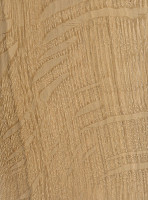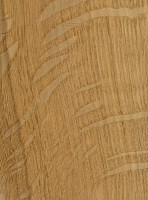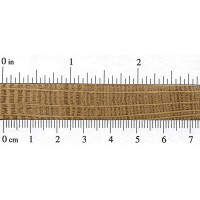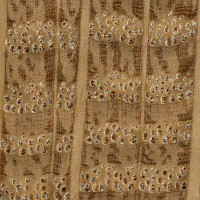 |
Common Name(s): Post Oak
Scientific Name: Quercus stellata Distribution: Eastern United States Tree Size: 40-60 ft (12-18 m) tall, 1-3 ft (.3-1 m) trunk diameter Average Dried Weight: 47 lbs/ft3 (750 kg/m3) Specific Gravity (Basic, 12% MC): .60, .75 Janka Hardness: 1,350 lbf (5,990 N) Modulus of Rupture: 13,070 lbf/in2 (90.1 MPa) Elastic Modulus: 1,495,000 lbf/in2 (10.31 GPa) Crushing Strength: 6,530 lbf/in2 (45.1 MPa) Shrinkage:Radial: 5.4%, Tangential: 9.8%, Volumetric: 16.2%, T/R Ratio: 1.8 |
Color/Appearance: Has a light to medium brown color, though there can be a fair amount of variation in color. Conversely, Red Oak tends to be slightly redder, but is by no means a reliable method of determining the type of Oak.
Grain/Texture: Has medium-to-large pores and a fairly coarse grain.
Rot Resistance: Post Oak has been rated as having very good resistance to decay. It is said that this wood has been used for fence posts, and may be where it got its name.
Workability: Easy to glue, and takes stain and finishes very well.
Odor: Has a tell-tale smell that is common to most oaks. Most find it appealing.
Allergies/Toxicity: Although severe reactions are quite uncommon, oak has been reported as a sensitizer. Usually most common reactions simply include eye and skin irritation, as well as asthma-like symptoms. See the articles Wood Allergies and Toxicity and Wood Dust Safety for more information.
Pricing/Availability: Slightly more expensive than Red Oak, White Oak is in good/sustainable supply and is moderately priced. Thicker 8/4 planks, or quartersawn boards are slightly more expensive per board foot.
Sustainability: This wood species is not listed in the CITES Appendices or on the IUCN Red List of Threatened Species.
Common Uses: Fence posts, cabinetry, furniture, interior trim, flooring, boatbuilding, barrels, and veneer.
Comments: Post Oak falls into the white oak group, and shares many of the same traits as White Oak (Quercus alba). White Oak, along with its brother Red Oak, are commonly used domestic lumber species. Hard, durable, and moderately priced, White Oak presents an exceptional value to woodworkers—which explains why it is so widely used in cabinet and furniture making.
- Black Oak (Quercus velutina)
- Bog Oak
- Brown Oak
- Bur Oak (Quercus macrocarpa)
- California Black Oak (Quercus kelloggii)
- Cherrybark Oak (Quercus pagoda)
- Chestnut Oak (Quercus prinus)
- English Oak (Quercus robur)
- Holm Oak (Quercus ilex)
- Japanese Oak (Quercus mongolica)
- Laurel Oak (Quercus laurifolia)
- Live Oak (Quercus virginiana)
- Oregon White Oak (Quercus garryana)
- Overcup Oak (Quercus lyrata)
- Pin Oak (Quercus palustris)
- Red Oak (Quercus rubra)
- Scarlet Oak (Quercus coccinea)
- Sessile Oak (Quercus petraea)
- Shumard Oak (Quercus shumardii)
- Southern Red Oak (Quercus falcata)
- Swamp Chestnut Oak (Quercus michauxii)
- Swamp White Oak (Quercus bicolor)
- Turkey Oak (Quercus cerris)
- Water Oak (Quercus nigra)
- White Oak (Quercus alba)
- Willow Oak (Quercus phellos)
 |
 |
 |
 |





Has anyone turned a small project out of Post Oak?
I have turned tool handles and a small bat, super heavy, sharp tools needed.
Alex, what do you recommend for using screws to keep it in place. I’m having a hard time just getting the screws to penetrate. Help!
Try drilling a small pilot hole, half the diameter of your screw. And use stainless steel kreg’s sell stainless steel screws for a variety of applications. If you use a drywall screw sometimes they will snap into and then you’re screwed yourself so stainless steel pilot hole take it easy you should be good to go.
I can say one thing for post oaks never use them as fire wood. All they do is smoke. My neighbor had two of these trees in his yard. He cut them down and then he decided to burn the 3’ stump. Well fast forward 15 years and yeah he was finally able to burn them completely down to the ground. He put everything from gasoline to diesel to burn these stumps and all that caught fire was the gas and diesel the stumps just smoked and burned a little bit at the time.
I’ve burned a lot of stumps you can put a barrel with both ends removed over the stump then put a rock or anything that want burn under one side to create a updraft or chimney effect then start your fire
post oak is great as firewood. its the primary wood used at just about any central texas bbq place.
Post oak is great firewood, it just takes longer to dry than say, Hickory.
The reason being it is still full of water if it’s not completely dry it is not going to burn he should have had them dug up and dry for two years maybe three and then he could have burned them, only common sense would have told him that. If it’s not down around 15 or 16% moisture is not going to burn maybe even lower.
Post oak is one of the best oaks for firewood. And around here, it is also one of the best smoking woods …IF it is still wet.
You’ll burn a lot of wood trying to burn Post Oak for firewood. If it’s it’s one of the best Oaks for firewood, it’s safe to assume it must be the only Oak species in your area. Just about all other species of Oak is a much better choice for firewood. Post Oak is known for being fire resistant and is stated as such in the description.
Post Oak is known for its fire resistance. All those making comments that it’s a great firewood must not heat with wood.
I’m trying to identify this tree. I’m quartering it with an Alaskan saw mill. Based on the rays, I’m guessing it is a Post Oak. Is this correct?
yes you are correct i work with this wood all the time at my work shop
How’d that post oak turn out for ya?